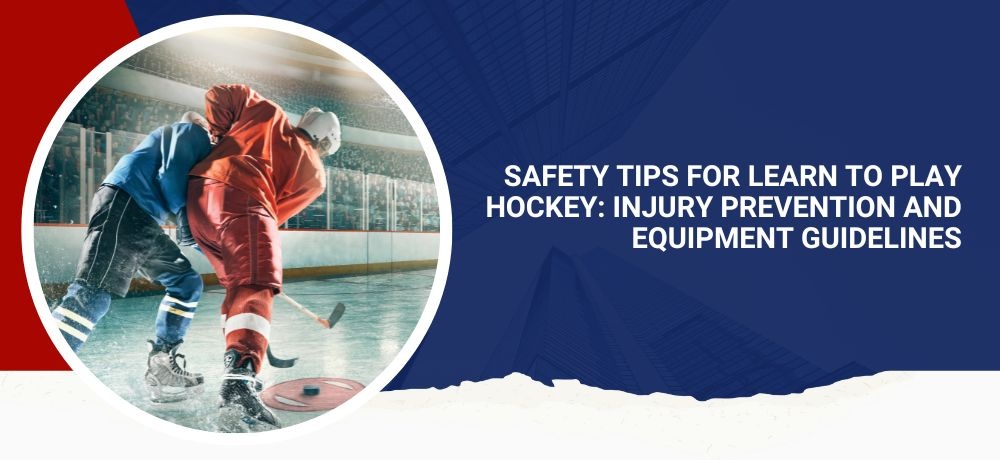Hockey injuries can be prevented through proper conditioning and protective gear. In this guide, we will explore effective strategies to minimize the risk of injuries on the hockey field.
We will discuss the importance of pre-game warm-ups, stretching exercises, and strengthening activities to enhance flexibility and muscle strength. Furthermore, we will cover the significance of using appropriate protective gear such as helmets, mouthguards, shin guards, and shoulder pads. By following these preventive measures, players can enjoy the game while reducing the chances of sustaining injuries.
Whether you are a player, coach, or parent, this guide will provide valuable insights on ensuring the safety and well-being of hockey enthusiasts.
The Importance Of Hockey Injury Prevention
The Importance of Hockey Injury Prevention
Hockey is a thrilling sport that requires physicality and skill. However, it is essential to understand the risks involved in playing hockey to promote a safe and enjoyable experience for players of all levels. Injuries in hockey can range from minor bruises and cuts to more severe fractures and concussions. By implementing effective injury prevention strategies, players can minimize the likelihood of getting injured on the ice.
One critical aspect of hockey injury prevention is proper training and conditioning. It is crucial for players to maintain good overall fitness and strength, including focusing on exercises that improve balance, agility, and flexibility. Having a strong foundation helps reduce the risk of falls and strains during gameplay.
Another key factor in injury prevention is the use of appropriate protective gear. Wearing a well-fitted helmet, mouthguard, padding, gloves, and skates with proper ankle support are essential to protect against head, facial, and limb injuries. Ensuring that equipment is regularly inspected and in good condition is also important.
Additionally, learning and following the rules of the game and practicing good sportsmanship are crucial aspects of preventing injuries in hockey. Respecting opponents and avoiding dangerous actions that could lead to collisions or unnecessary physical contact contribute to a safer playing environment.
Lastly, maintaining open communication between players, coaches, and medical professionals is vital. This allows for prompt identification and treatment of any injuries or health concerns. Ensuring players are aware of the signs and symptoms of common hockey injuries, such as concussions and sprains, empowers them to take appropriate action and seek medical attention when needed.
| Key Strategies |
|---|
| Proper training and conditioning |
| Use of appropriate protective gear |
| Following game rules and practicing sportsmanship |
| Effective communication and prompt medical attention |

Credit: www.uab.edu
Proper Warm-Up Techniques
Hockey injuries can be greatly reduced with proper warm-up techniques. One essential component of warming up is dynamic stretching exercises, which help to improve flexibility and mobility. Dynamic stretching involves controlled movements that mimic the actions performed during hockey gameplay.
An important aspect of warm-up is cardiovascular exercises, which increase blood flow to the muscles. This helps to prepare the body for the physical demands of hockey and reduces the risk of injury. Engaging in activities such as jogging or jumping jacks for a few minutes can effectively raise the heart rate and warm up the body.
Additionally, it is crucial to focus on specific areas of the body that are prone to injury in hockey, such as the ankles, knees, and shoulders. Incorporating exercises that target these areas, such as ankle rotations, knee lifts, and shoulder circles, can help to prevent injuries.
Proper warm-up techniques, including dynamic stretching exercises and cardiovascular activities, are essential for preventing hockey injuries. By dedicating time to warm up before playing, players can improve their flexibility, mobility, and overall performance while reducing the chances of getting injured.
Essential Protective Gear For Hockey
Hockey Injuries Prevention Guide
Protective gear is crucial in hockey to prevent injuries. One of the most important pieces of equipment is a helmet that provides head protection. When choosing a helmet, consider the following:
| Factors to Consider | Important Points |
|---|---|
| Fit | Ensure the helmet fits snugly on the head without any movement. It should cover the forehead and temples. |
| Padding | Look for helmets with adequate padding to absorb impact and provide comfort. |
| Certification | Choose helmets that meet the safety standards set by relevant organizations such as HECC or CSA. |
Aside from helmets, it’s essential to have proper padding and protective gear for different body parts. Here are some points to consider:
- Select shoulder pads that cover the upper body, including the collarbone and upper arms.
- Opt for elbow pads that offer a comfortable fit and protect the elbows and forearms during falls or collisions.
- Invest in hockey gloves that provide hand and wrist protection while allowing flexibility for stick handling.
- Wear shin guards that cover the lower legs and knees to protect against slashes and impacts.
- Choose hockey pants that have adequate padding in the hips, thighs, and tailbone areas.
Properly fitting gear is essential to ensure maximum protection. It is important to:
- Regularly check the fit of all gear to ensure it is snug and secure.
- Inspect gear for any signs of wear and tear, such as frayed straps or cracked padding, and replace as necessary.
- Clean gear regularly to prevent bacteria buildup and unpleasant odors.
- Follow manufacturer’s guidelines for maintenance and care.
Lower Body Injury Prevention
| Hockey Injuries Prevention Guide |
Lower Body Injury Prevention |
|
Proper skating technique can help reduce strain on joints and prevent lower body injuries. It’s important to focus on strengthening the muscles that support the lower body to improve stability and prevent injuries. Exercises that target the quadriceps, hamstrings, glutes, and calves can help improve strength and prevent common injuries such as ankle sprains and knee strains. Incorporating exercises like squats, lunges, leg presses, calf raises, and hip abductions can help build strength in these muscles and enhance performance on the ice. It’s also crucial to pay attention to proper form and technique while performing these exercises to avoid putting unnecessary strain on the body. |
Upper Body Injury Prevention
Hockey players are prone to upper body injuries due to the physical nature of the sport. **Strengthening exercises** for the upper body can help prevent such injuries. These exercises should focus on developing the muscles in the arms, shoulders, and chest. Additionally, correct stick handling techniques should be emphasized to minimize strain on the wrists and shoulders. This involves maintaining proper form and using the appropriate grip on the hockey stick.
Strategies for preventing common upper body injuries are also crucial. Players should be educated on the **prevention of shoulder dislocations** and how to minimize the risk of hand fractures. This includes practicing proper body positioning and avoiding unnecessary contact or collisions during gameplay. Regular rest and recovery are also important to allow the body to heal and prevent overuse injuries.
Injury Prevention Through Conditioning
Hockey injuries can be prevented through proper conditioning. It is important to maintain overall fitness and conditioning to minimize the risk of injuries. Developing strength and endurance specifically tailored to the demands of hockey can help athletes stay injury-free. Incorporating cross-training activities into their routine can further support hockey performance and prevent injuries. By focusing on building the necessary physical capabilities, hockey players can enhance their ability to withstand the physical demands of the game and reduce the likelihood of injuries.
Safe Checking And Collision Techniques
Safe checking and collision techniques are essential in preventing hockey injuries. Proper body positioning and timing are crucial for safe checking. Players should maintain a low stance with their knees slightly bent and their weight centered for better stability. It is important to reduce the risk of head and spinal injuries during collisions. Wearing a well-fitted helmet and neck guard is essential to protect the head and neck areas. Additionally, players should focus on sportsmanship and respect for opponents to minimize dangerous plays. Effective communication on the ice is important to avoid collisions and ensure player safety.
Concussion Prevention And Awareness
|
Concussion Prevention and Awareness Concussions are a serious concern in hockey, and it is crucial to recognize the signs and symptoms to prevent further injury. Common signs include headache, dizziness, confusion, and memory loss. If any player exhibits these symptoms, it is important to report and manage the concussion immediately. Educating athletes, coaches, and parents about the risks and consequences of concussions is essential. Increased awareness can lead to timely intervention and proper treatment, minimizing the potential long-term effects. Prevention tactics such as wearing proper helmets, following safe playing techniques, and enforcing strict penalties for dangerous hits can significantly reduce the risk of concussion. By prioritizing concussion prevention and raising awareness, the hockey community can strive towards a safer environment for all players. |
Injury Management And Recovery
Injury management and recovery are crucial aspects when it comes to preventing and addressing hockey injuries effectively. Immediate first aid measures for common injuries on the ice can significantly contribute to minimizing the severity of the injury and promoting a faster recovery. It is essential to seek professional medical attention when necessary to receive proper diagnosis and treatment. Following this, rehabilitation exercises and recovery strategies play a vital role in getting back on the ice quickly and safely. These exercises are specifically designed to gradually strengthen and restore the injured areas, allowing players to regain their physical abilities and confidence. Additionally, adhering to a comprehensive rehabilitation program can also help prevent future injuries. The combination of immediate first aid, professional medical attention, and dedicated rehabilitation efforts are key elements in ensuring a smooth recovery process and promoting overall player safety in the game of hockey.
Frequently Asked Questions For Hockey Injuries Prevention Guide
What Are The Most Common Injuries For Hockey Players?
The most common injuries for hockey players include concussions, sprains, fractures, and ligament tears.
How To Play Ice Hockey Safely?
To play ice hockey safely, follow these guidelines: 1. Wear proper protective gear to prevent injuries. 2. Learn and practice proper techniques for skating, shooting, and checking. 3. Be aware of your surroundings and communicate with teammates. 4. Respect the rules of the game and engage in fair play.
What Are The Overuse Injuries In Hockey?
Overuse injuries in hockey include tendonitis, stress fractures, shin splints, and shoulder impingement.
What Happened To Morgan Barron?
Morgan Barron’s status or situation is currently not available or reported.
Conclusion
As we wrap up this comprehensive Hockey Injuries Prevention Guide, it is evident that taking proactive measures on and off the ice is crucial for players’ safety and well-being. By implementing a proper warm-up routine, focusing on proper technique, and wearing the necessary protective gear, players can significantly reduce their risk of injury.
Additionally, staying physically fit through regular strength and conditioning exercises can help build a robust body that can withstand the physical demands of the game. It is essential to be aware of the most common injuries in hockey and take preventive measures, such as strengthening the core and improving balance and stability.
Lastly, never underestimate the importance of rest and recovery, as getting enough sleep and allowing the body ample time to heal can make a significant difference in injury prevention. By following this guide, players can continue enjoying the sport they love while minimizing the risk of hockey-related injuries.
Stay safe and play smart!


